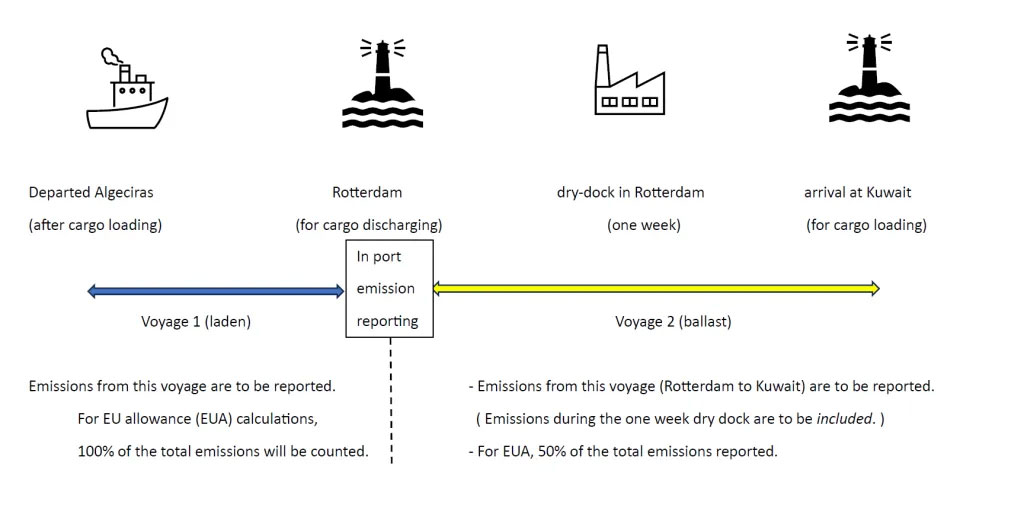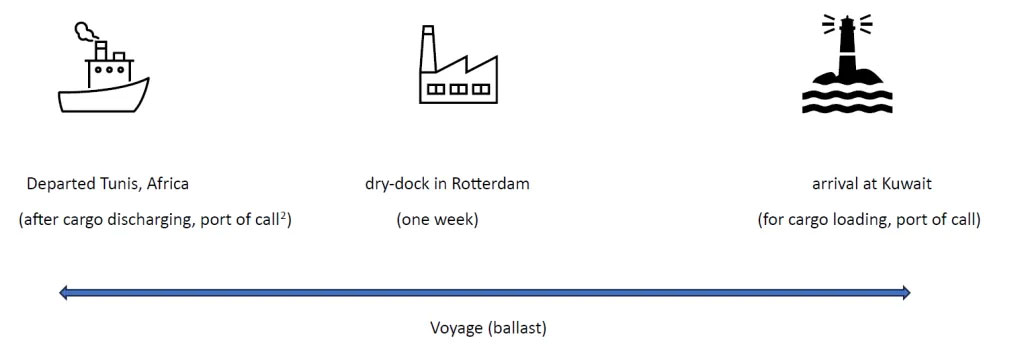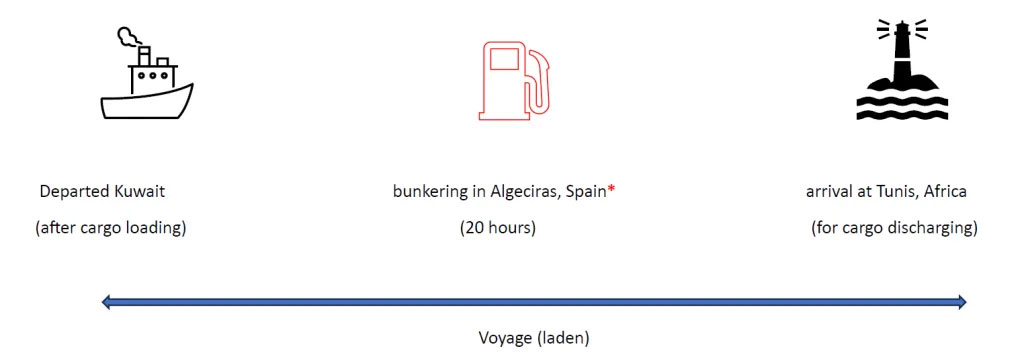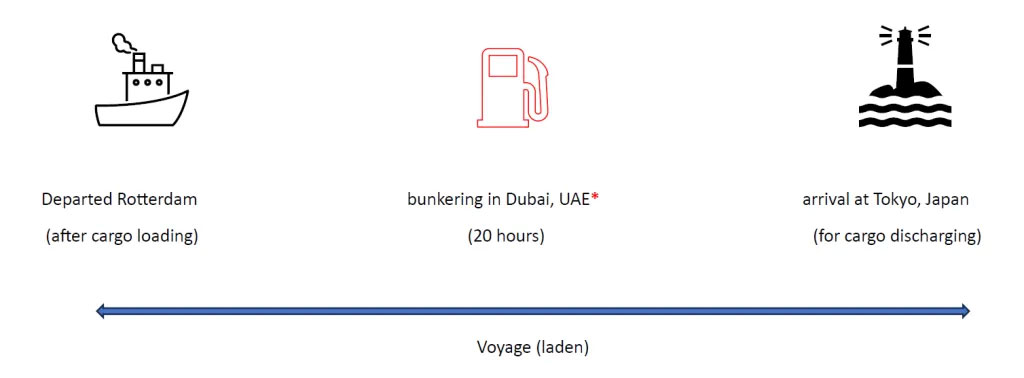8 Case Studies for EUAs calculations

The purpose of this Case Study is to seek uniform application of the
MRV reporting requirements, hence uniform allocation of EU
allowances.
MRV, ETS and FuelEU have the same definitions of ‘voyage’, port of
call’ and ‘reporting period’ albeit in somewhat slightly different
languages.
Case 1: 50% & 100% of the emissions from a ship performing a voyage
For EU allowance allocation purposes, the legal basis for 50%
counting of the emissions from a ship performing a voyage between a
port of call within EU/EEA and a port of call within non-EU/EEA is
provided in Article 3ga of the revised ETS Directive.
100% for emissions from a ship performing a voyage between ports of
call within EU/EEA Member States.
Article 3ga
The allocation of allowances and the application of surrender requirements in respect of maritime transport activities shall apply in respect of fifty percent (50 %) of the emissions from ships performing voyages departing from a port of call under the jurisdiction of a Member State and arriving at a port of call outside the jurisdiction of a Member State, fifty percent (50 %) of the emissions from ships performing voyages departing from a port of call outside the jurisdiction of a Member State and arriving at a port of call under the jurisdiction of a Member State, one hundred percent (100 %) of emissions from ships performing voyages departing from a port of call under the jurisdiction of a Member State and arriving at a port of call under the jurisdiction of a Member State, and one hundred percent (100 %) of emissions from ships within a port of call under the jurisdiction of a Member State.
The allocation of allowances and the application of surrender requirements in respect of maritime transport activities shall apply in respect of fifty percent (50 %) of the emissions from ships performing voyages departing from a port of call under the jurisdiction of a Member State and arriving at a port of call outside the jurisdiction of a Member State, fifty percent (50 %) of the emissions from ships performing voyages departing from a port of call outside the jurisdiction of a Member State and arriving at a port of call under the jurisdiction of a Member State, one hundred percent (100 %) of emissions from ships performing voyages departing from a port of call under the jurisdiction of a Member State and arriving at a port of call under the jurisdiction of a Member State, and one hundred percent (100 %) of emissions from ships within a port of call under the jurisdiction of a Member State.
Note the following provisions in this Article:
- Departing from a port of call outside
- Arriving at a port of call outside
- Arriving at a port of call under
The emissions from the last leg (voyage) and the first leg (voyage)
between port of call should be counted. Case 2 explains this
concept.
Case 2: The first leg (voyage) and the last leg (voyage) of a
journey, and evasion

The voyage between Algeria and Rotterdam (Leg 3) only shall be
reported and 50% of the emissions from this voyage shall be counted
for the EU allowance.
Background/evasion
The EU ETS only covers the last leg of the journey from a non-EU/EEA
port to an EU/EEA port, and the first leg of the journey from an
EU/EEA port to a non-EU/EEA port. The revised ETS Directive
recognizes ship operators’ possible evasive operation to reduce
their ETS obligations by adding a stopover in a nearby non-EU/EEA
port. Otherwise known as ‘carbon leakage’. In many cases, adding a
stopover in a nearby port would entail more costs than the compliant
operation.
For this reason, Article 3ga of the revised ETS Directive addresses
the container fleet using 65% of the total container traffic of the
port per 12 months and 300nm from a nearest EU port as the evasion
target criteria. The EC has announced ‘Port Said (Egypt)’ and
‘Tanger Med (Morocco)’ as the target container transshipment ports.
No other ship types are targeted. However, the EC will monitor the
maritime ETS implementation to detect evasive behavior at an early
stage (Ref: EC Implementation Reg. (EU) 2023/2297 on identifying
container transshipment ports pursuant to Article 3ga).
These two ports will be excluded from the definition of ‘port of
call’ for container fleet only.
Note that the definition of ‘port of call has such a long text
excluding bunkering, drydock, distress, safety, STS outside the
port, crew change, e’cy repair and so forth. This is to prevent the
ships from using these calls as a pretext to avoid the MRV/ETS
obligations. See Case 3~7
Case 3: Voyage from Non-EU, via a EU country for cargo operation and
dry-dock, to Non-EU
According to the definitions of the revised MRV Regulation and the
revised ETS Directive,
- Voyage1 is from ‘Port of Call to ‘Port of Call, into, within or out of EU/EEA.
- Bunkering, dry-dock, e’cy repair, or crew change etc alone are not counted as a ‘Port of Call (where there is no cargo operation).
- “voyage” means any movement of a ship that originates from or terminates in a port of call;

Case 4: Voyage from Non-EU, via a EU country for dry-dock, to Non-EU

Emissions from this voyage should not be reported and not counted in
EU allowance calculations.
In the Revised ETS Directive: “port of call” means the port where a
ship stops to load or unload cargo or to embark or disembark
passengers, or the port where an offshore ship stops to relieve the
crew; stops for the sole purposes of refueling, obtaining supplies,
relieving the crew of a ship other than an offshore ship, going into
dry-dock or making repairs to the ship, its equipment, or both,
stops in port because the ship is in need of assistance or in
distress, ship-to-ship transfers carried out outside ports, stops
for the sole purpose of taking shelter from adverse weather or
rendered necessary by search and rescue activities, and stops of
containerships in a neighboring container transshipment port listed
in the implementing act adopted pursuant to Article 3ga(2) are
excluded;
Case 5: voyage from Non-EU, via a EU country for bunkering,
emergency repair, crew change etc, to a non-EU

Emissions from this voyage should not be reported and not counted in
EU allowance calculations.
It could be emergency repair or crew change
Case 6: Voyage from EU, via a Non-EU country for bunkering, to
Non-EU

Emissions from this voyage (Roterdam – Dubai – Tokyo) should all be
reported. The EU allowance calculation will be represented by 50% of
the total emissions from this voyage.
Case 7: Ship to Ship (STS) transfer carried out outside ports
The European Commission
(EC) FAQ web site:
Q: Are ship to ship transfers carried out outside ports
subject to the MRV Regulaon?A: “Ship to ship” transfers carried out outside ports are covered by the Regulaon as part of a voyage calculated from the last port of call to the next port of call. Variations of cargo arising from “ship to ship” transfers outside ports during a voyage should be taken into account. In those cases, a weighted average for cargo carried should be calculated and applied to the entire voyage.
The following case is well explained from 03:20min to 04:13min:

MRV Reporting for this Voyage:
Total 320 mile, 77,500 ton cargo (average weighted), 68 hours
time at sea, 450 ton fuel consumption, 1,350 ton CO2 emitted.
Note: ‘Time at sea’ does not include time at anchorage’ but does
include time at STS’.
Case 8: Reporting period year-end
The definition of ‘reporting period’ has been changed in the revised
MRV Regulation. The same definition applies to FuelEU Maritime.
| MRV Regulation 2015(757) | The revised MRV regulation 2023(957) (effective 1 Jan 2024) |
FuelEU Maritime Regulation (effective 1 Jan 2025) |
| (m) ‘’reporting period’’ means one calendar year
during which CO2 emissions have to be monitored and
reported. For voyages starting and ending in two
different calendar years, the monitoring and reporting data shall be accounted under the first calendar year concerned; |
(m) “reporting period” means the period from 1 January until 31 December of any given year; for voyages starting and ending in two different years, the respective data shall be accounted under the year concerned; |
(m) ‘’reporting period’’ means a period from 1 Jan to 31 Dec of the year during which information referred to in this Regulation is monitored and reported, where data for voyages starting and ending in two different calendar years is accounted under the calendar concerned. |
- Under the new definition, voyages or port stays spanning over the turn of the year will be separated into the first set of data lasting until 31st December of the reporting year and the 2nd set of data starting from 1st January of the next reporting year.
- Transition: For emissions of the reporting year 2023, the previous definition applies. For the reporting year 2024, emissions recorded from 1 Jan 2024 shall be included in the Emissions Report.
- We understand that in the IMO DCS reporting system, the reporting period is already treated as a calendar year from 2019.
- Members are advised to check their MRV IT systems to see whether they can cope with the reporting (calendar) year.